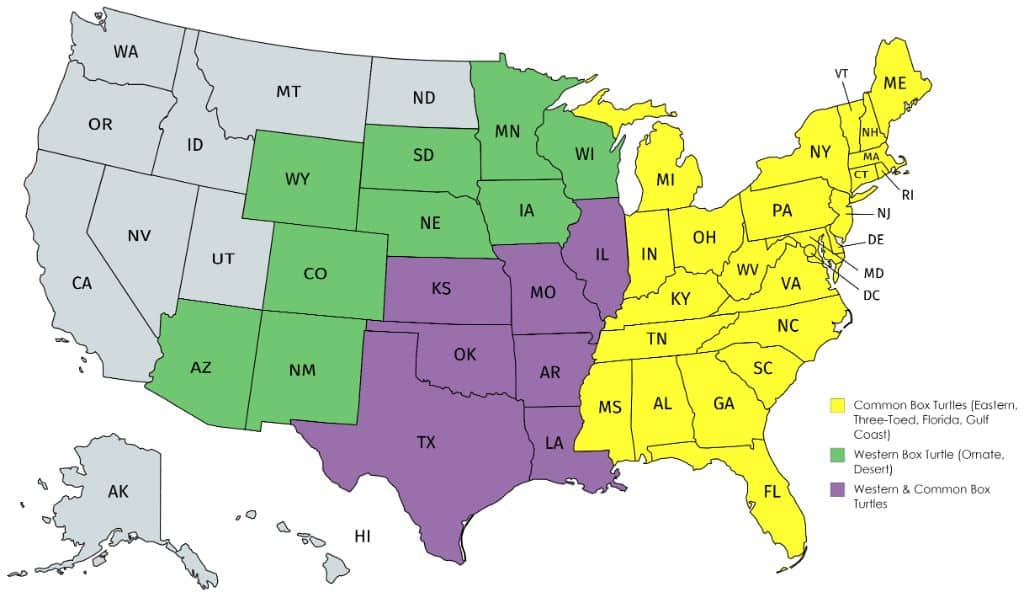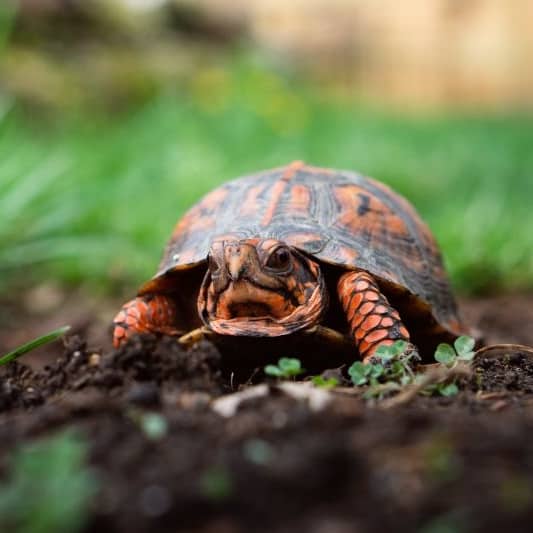The box turtle is a popular pet turtle in North America and other parts of the world. The name box turtle comes from the turtles’ ability to retract their body completely into the shell, leaving nothing but a box.
The lower part of the shell, called the plastron, has hinges with the ability to close the shell up when the turtle has retracted its body. Box turtles use this ability as a protection mechanism when they fear any danger. With their hard armored shell, they are completely protected from predators like foxes, coyotes, snaked or owls. In the first year or two, baby box turtles do not have this ability and their shell is still soft and vulnerable. Therefore, they are easy prey for many larger animals and only few box turtles in the wild reach adulthood.
This page provides an overview of the most important box turtle facts, tips for pet turtle keepers and much more. Here is a short overview of the contents. Just click on the links to get to the respective section.

Box Turtle Care
Tips and information on things you need to know when you keep a box turtle as a pet. The best indoor habitats, box turtle diet, where to buy a box turtle, how to breed baby box turtle and much more.
Read More…
Box Turtle Knowledge
How can you tell if a box turtle is male or female? How old does a box turtle get? Are box turtles endangered? Here you will find all information about box turtles.
Read More…


Box Turtle Species
An overview of all species of box turtles. From Eastern box turtles, Western box turtles to Asian box turtles. Here you can find an overview of all types of box turtles.
Read More…
Box Turtle Facts
The different species of box turtles
Worldwide, there are two animal families of box turtles: North American box turtles and Asian box turtles. All species of the American box turtles are part of the genus Terrapene while Asian box turtles are part of the genus Cuora.
Both genera have several species that differ in their natural habitat, size, body color and overall behavior. The most common box turtles that are also often kept as pets are the Eastern Box Turtle, the Western Ornate Box Turtle, the Florida Box Turtle and the Three-toed Box Turtle.
Other box turtle species are native to the southern states of the US and Mexico. Due to a decreasing natural habitat and the vulnerability of hatchlings in the wild, box turtle numbers have decreased greatly over the last decades. Several states in the US and other countries prohibit the removal of wild box turtles and the sale of box turtles.
Click here to get to our full overview of all types of box turtles around the world.
The natural habitat of a box turtle
The different species of box turtles are native to various regions in North America and Asia. Therefore, their natural habitat differs greatly from each other. Wild box turtles have rather small home range that they never leave. The roam around their known territory and know every rock, pond and stream in their area.
Species of the common box turtle Terrapene carolina live in forests in Eastern North America
The Eastern box turtle, Terrapene carolina carolina, and Three-toed box turtle, terrapene carolina triunguis, lives in forests and feeds on forest plants, fruits worms and other forest animals. They can be found in the Eastern United States, South-Eastern Canada and in Eastern Mexico. In the US, they are native from Maine to Illinois and down to Texas and Florida.
The Western box turtle Terrapene ornata lives in grasslands in the Great Plains
As the name suggests, the Western box turtle, especially the Ornate box turtle, Terrapene ornata ornata, can be found more to the west in the United States – but not on the West Coast. Their natural range reaches from Illinois to Wisconsin and down south to Wyoming and Louisiana.
As opposed to the Eastern box turtle, the Western Ornate box turtle is often found in grasslands outside of forests. They are used to more dry and higher temperatures than their relatives in the East who mainly live in cooler, more humid forest areas.,
Distribution of the box turtle genera in the United States

Box Turtle Care
Box turtles are omnivores and eat any type of food. However, a balanced diet is crucial for their health. The ideal box turtle diet consists of 50% proteins, 30% vegetables, 10% leafy greens and 10% fruits.
The ideal box turtle habitat offers the turtle a hiding spot, a water area, a feeding station, plants and soil to dig. We collected some important tips and tricks on box turtle housing and four instructions for indoor and outdoor box turtle habitats.
Many aspects of its surroundings influence the health of a box turtle. But regardless of how great you care for your pet turtle, it may get sick at some point. This post provides and overview of common health issues of box turtles, how you can deal with it and when to visit a vet. Read More

Box Turtle lifespan – How long do they live?
In the wild, the majority of box turtles of the genus Terrapene will not grow older than two years due to their vulnerability to predators. A turtle that makes it to the age where its shell develops the hinge to retract into, will be able to protect itself and has few natural enemies.
After surviving the tough hatchling phase, a wild box turtle reaches an average age of around 50 years. Many box turtles even live for over 100 years.
For pet box turtles, the hatchling mortality is much lower. They are often incubated indoors in incubators that offer ideal conditions and grow up protected from predators and have access to a steady food supply and medical care in case of any complications.
However, due to their complicated diet, light and heat requirements, pet box turtles have a lower life expectancy than wild turtles. Their average life expectancy ranges from 35-60 years. Especially for box turtles that are kept indoors, an ideal habitat with lights, heat, humidity and a balanced diet are necessary to prevent various diseases.
Overall, the smaller Ornate box turtles have a shorter lifespan than Eastern box turtles or Three-toed box turtles.
How to tell the age of a box turtle?
Some sources state that counting the rings on the scutes of a box turtle’s shell will give away its age. And while this method helps to indicate the rough age of a box turtle, it is not an exact age determination method. Overall, there are ways to roughly determine the age of a young box turtle. However, once the box turtle has reached adulthood after around 7 to 10 years of age, there will be no way to tell its age.
How to approximately determine the age of a box turtle by counting their scute rings
Around the year, the shell of a box turtle in the wild and in captivity grows in several intervals. During the winter months, the growth is slower while it picks up in spring. Through the seasons, box turtles usually develop around two rings on every scute per year. Therefore, you can count the rings and divide the number by two to approximately tell how old a box turtle is. This method is only an indication of age and only works up to an age of around seven years. After that, the rings grow too close together and it becomes impossible to count them.

Or measure the size of your box turtle to guess the age
For older box turtles, the only other method to determine the age is by measuring its size and estimating the age. First, identify the species of box turtle you have and compare its size with the average size of other box turtles of its species. You can find all necessary information about the various types of box turtles and their sizes here or in the next paragraph. However, also this method is only good to determine the age of a box turtle that is still relatively young. After a maximum of ten years, a box turtle has usually reached its full size. So it may be near impossible to tell the difference between a 10 year old or 100 year old box turtle.
How big do box turtles get
The size of a box turtle depends on several factors. Most importantly, obviously, is its species. Here is an overview of the average size of an adult Western and Common Box Turtle:
- Eastern box turtles: 4-6 inches (10-15 cm). Largest ever recorded: 7.8 inches (20 cm).
- Three-toed box turtles: 4-6 inches (10-15 cm). Largest ever recorded: 6.5 inches (16.5 cm).
- Ornate box turtles: 4-5 inches (10-13 cm). Largest ever recorded: 5.9 inches (15 cm).
- Gulf Coast box turtles: 5-7 inches (13-18 cm). Largest ever recorded: 8.5 inches (22 cm).
Hatchlings are usually the size of a quarter and grow to their full size in less than 10 years. The size of a box turtle is also greatly influenced by its diet and habitat. A turtle that receives to little sunlight or a diet low in calcium or other important vitamins and minerals may have a health issue and limited growth.
Can box turtles swim?
Yes, box turtles have the ability to swim. Unlike other turtles or tortoises, however, North American box turtles do not live in water or spend a lot of time under water. Their ability to swim is mainly beneficial and used when they fall into water or need to cross a flowing stream of water.
Box turtles have individual toes on their feet with claws that are made for walking on ground. This means that they will have more difficulty moving in water than most other type of turtle who usually have webbed feed.
Most species of the Cuora genus, commonly called Asian box turtles, live in hot and humid areas of Eastern and South-Eastern Asia. Their natural habitats are around bodies of water and they are more adept to swimming than their North American relatives.
Box Turtle Knowledge
The shell of a box turtle consists of an upper part, called carapace, and a lower part, called plastron. The two parts are directly connected. Thanks to the domed shell and a hinge on its plastron, a box turtle can fully retract its body into the shell.
Identifying the gender of a box turtle is a little harder than with most other animals. But their colors, size or the shape of their shell often gives away their gender. Learn how to tell the sex of your box turtle.
Carapace, plastron, omnivore, chelonian and so many more. Box turtle guides are full of technical terms. To unravel the mystery, we collected them in our glossary.
How to tell the gender of a box turtle
Since the genitalia of a box turtle are not visible from the outside, other secondary sex characteristics have to be used to determine the gender. While telling the gender of hatchling box turtles can be difficult, it is usually rather easy to tell for box turtles older than two years.
For Eastern box turtles, the male usually has red eyes, while a female has brown eyes. Also the shell, legs and the head of a male Eastern box turtle is usually more colorful than a female’s. The gender of Ornate box turtles can usually be determined by the color of the head. Males have a green head while female Ornate box turtles have a brown head. For all species, a concave plastron, curved toes and a thick tail are indications for male box turtles.


Learn more about how to tell the gender of your box turtle in this detailed post
Box turtle hibernation
Wild box turtles hibernate during the winter months for three to four months. In some warmer parts of North America, box turtles may also just hibernate for a few weeks or even remain active throughout the winter months.
Once the outside temperatures fall, a box turtle will get less active and stop eating. It will search for an appropriate place to dig into the ground and hide under the earth, below the freeze line. Some wild box turtles have been found at a depth of over two feet (60 cm) below the ground. During the time of hibernation, they will lose up to 25% of their body weight.
If you are keeping a pet turtle, you can find more information about do’s and don’t as well as helpful tips for box turtle hibernation in this post.
We hope this post has learned you a lot about the most important box turtle facts. Let us know in the comment section below if you have any further questions. Use the links in the menu above or below to navigate to the detailed posts about each section.
Suggested Reading
If you keep or are planning to keep a box turtle yourself, check out the book “BOX TURTLES” by site founder Tess Cook.
The book covers a broad range of topics around box turtles and is a good source for husbandry for both North American box turtles (Terrapene) and Asian box turtles (Cuora).
> You can find it here on Amazon.com (affiliate link) or in many pet supply stores
Join the Box Turtle List!
Join a group of active turtle keepers and enthusiasts at the box turtle list maintained by site founder Tess Cook. It doesn’t matter if you are new to to the cute little reptiles or a long time keeper, here you will find a great community and helpful tips and tricks about box turtles.
> Join Now
Our Picture Gallery – Box Turtle Pictures
Check out our collection of beautiful box turtle pictures here. Including several cute baby turtle pictures. Just click here to get to our gallery. If you have box turtles yourself, we would be happy to include them. Just send your pictures to boxturtlesite@gmail.com


